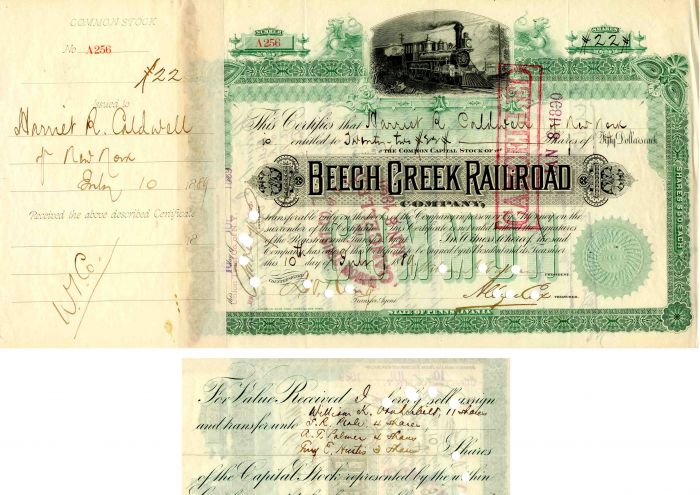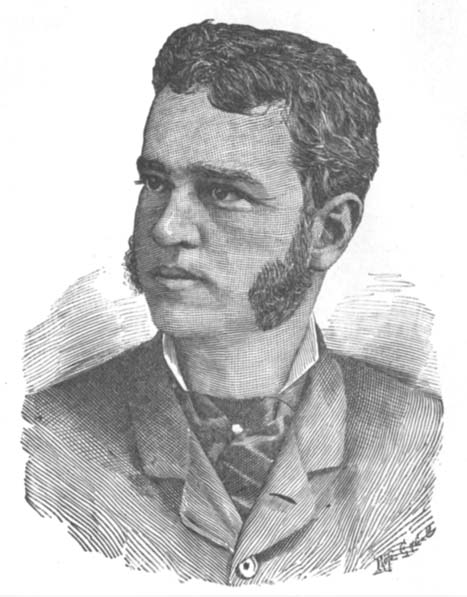Beech Creek Railroad Co. transferred to Wm. K Vanderbilt - Stock Certificate
Inv# AG2363 Stock
Stock transferred to Wm. K Vanderbilt, not signed.

William Kissam Vanderbilt (1849-1920) A member of the prominent United States Vanderbilt family.
The second son of William Henry Vanderbilt, from whom he inherited $60 million, he was for a time active in the management of the family railroads, though not much after 1903. His sons William Kissam Vanderbilt II (1878-1944) and Harold Stirling Vanderbilt (1884-1970) were the last to be active in the railroads, the latter losing a proxy battle for the New York Central Railroad in the 1950s.
William K. Vanderbilt's first wife was Alva Erskine Smith (1853-1933), who he married in 1875. Born in 1853 to a slave-owning Alabama family, she was the mother of his children and was instrumental in forcing their daughter Consuelo (1877-1964) to marry the 9th Duke of Marlborough in 1895. Not long after this the Vanderbilts divorced, William K. later marrying Anne Harriman Rutherford Sands and Alva marrying Oliver Hazard Perry Belmont.
After the death of his brother Cornelius Vanderbilt II in 1899 he was generally regarded as head of the Vanderbilt family.
Like other members of his wealthy family, he built magnificent Vanderbilt houses. His homes included Idle Hour (1900) on Long Island, New York and Marble House (1892), designed by Richard Morris Hunt who also designed his 660 Fifth Avenue mansion (1883), in Newport.
William Kissam Vanderbilt died in Paris, France in 1920. His remains were brought home and interred in the Vanderbilt family vault in the Moravian Cemetery at New Dorp on Staten Island, New York.
The Beech Creek Railroad is a defunct railroad which operated in central Pennsylvania between Jersey Shore and Mahaffey. Originally chartered in 1882, it was leased by the New York Central and Hudson River Railroad (later the New York Central Railroad) in 1890 and was directly operated by that company afterwards. Much of the line was abandoned in the second half of the 20th century, though sections at both ends are still active.
The company was originally chartered as the Susquehanna and South Western Railroad on August 12, 1882. That company's charter called for a 100-mile (160 km) line from Williamsport, Pennsylvania to the southern line of Clearfield County. The proposed line was initiated with the backing of the New York Central Railroad, as part of a far-reaching strategy to ensure access to bituminous coal reserves. The New York Central did not itself extend into the bituminous coalfields, making it vulnerable to action both by the coal operators who mined the coal and rivals like the Pennsylvania Railroad, who carried it. The coal operators of Tioga County, Pennsylvania, some of whom already shipped over the New York Central via the Fall Brook Coal Company's railroad system, faced irrepressible labor troubles and the impending exhaustion of their mines. William H. Vanderbilt, president of the New York Central, responded to the challenge by developing a plan to enter the Clearfield Coalfield, hitherto the exclusive preserve of the Pennsylvania Railroad. The Vanderbilts would provide capital to a syndicate of Tioga coal operators and businessmen of the Clearfield area, incorporated as the Clearfield Bituminous Coal Company, who could acquire coal lands without arousing suspicion. The Fall Brook's rail network, extended down Pine Creek by a paper railroad called the Jersey Shore, Pine Creek and Buffalo Railway, would bring the New York Central's trains to Jersey Shore, on the West Branch Susquehanna River to the west of Williamsport. From there, the Susquehanna and South Western would head west by way of Beech Creek and Moshannon Creek to the vicinity of Clearfield.
The initial incorporators of the railroad were William A. Wallace, B. L. Wallace, Israel Test, and E. H. Bigler, of Clearfield, S. R. Peale and William H. Brown of Lock Haven, John G. Reading and Joseph M. Gazzam, of Philadelphia. Gazzam was William Wallace's law partner; Reading, a wealthy banker, was Gazzam's father-in-law. William Wallace was appointed president. The railroad selected Samuel Brugger as its locating engineer: an experienced civil engineer, he had recently surveyed part of the same route on behalf of the Pennsylvania and Western Railroad, an independent vehicle of New York speculators which did not succeed in laying track. This allowed him to quickly complete his survey, which was approved by the board in September 1882.
The Pennsylvania Railroad did relatively little to block the construction of the Susquehanna and South Western. The failed Pennsylvania and Western had induced the Pennsylvania to charter the Lock Haven and Clearfield Railroad in 1879, which would have built from their Bald Eagle Valley Railroad at the mouth of Beech Creek to their Tyrone and Clearfield Railroad at Philipsburg, the same route that the Susquehanna and South Western would take, but never initiated construction. The Pennsylvania may have been influenced by a report from one of their civil engineers, Camille d'Invilliers, prepared in December 1883, which suggested that the Moshannon seam was being exhausted in the older collieries in the Philipsburg and Houtzdale area. Coal from the Moshannon seam enjoyed a high reputation, and d'Invilliers suggested that the Pennsylvania should concentrate on new fields exploiting the Moshannon seam, in the upper Moshannon Valley and elsewhere, and allow the New York Central to compete for the lower seams of Kittanning coal remaining in the Philipsburg area. The only known surviving copy of his report is in the archives of the Fall Brook Coal Company; this company was an ally of the New York Central in penetrating the coalfield, suggesting that the Pennsylvania and New York Central came to an understanding to allow the Beech Creek's construction.
The Susquehanna and South Western financed its construction with the issue of $4,000,000 in stock. Nearly all of the initial issue was purchased by William Wallace, Peale, and Reading, but these purchases were financed by the Vanderbilts and George Magee of the Fall Brook Coal Company, to whom most of that stock was then transferred starting in January 1883.
Construction began at the end of 1882, starting at the town of Beech Creek and proceeding west along the creek to Mountaintop, in the vicinity of Snow Shoe. The company changed its name to the Beech Creek, Clearfield, and South Western Railroad on March 20, 1883. Around this time, it increased the stock issue to $5,000,000 and issued an additional $5,000,000 in fifty-year bonds. The Clearfield Bituminous Coal Company signed a contract to ship exclusively over the new railroad, and George Magee was appointed general contractor for construction. The new line was built to high standards in anticipation of heavy coal traffic. It eschewed severe grades, at the cost of extensive curvature and bridges as it followed Beech Creek, and the 347 feet (106 m) Hogback tunnel, which cut across a loop of the creek, about halfway up the climb out of the watershed at Hurxthal's Summit. Tracklaying began in September 1883. In the meantime, construction began on the 1,277 feet (389.2 m) Peale tunnel 8 miles (10 km) west of the summit, on the descent approaching Moshannon Creek. Undertaken by the well-known railroad contractors P & T Collins, tunneling began on June 24, 1883 and the bore was holed through on October 30. It was ready for rail traffic by the middle of the next year. 2 miles (3 km) further west, the line crossed the creek on an iron viaduct 112 feet (34.1 m) high, opened for service on November 11, 1884.
The company failed and was sold to the newly organized Beech Creek Railroad on June 29, 1886. The New York Central and Hudson River Railroad officially leased the company on December 15, 1890, backdated to October 1. The New York Central merged the Cambria County Railroad into the Beech Creek Railroad on May 11, 1898.
An April 29, 1951 a New York Central Timetable listed the line as the "Pennsylvania Division" while an October 30, 1960 Timetable listed it as the "Syracuse Division."
A stock certificate is issued by businesses, usually companies. A stock is part of the permanent finance of a business. Normally, they are never repaid, and the investor can recover his/her money only by selling to another investor. Most stocks, or also called shares, earn dividends, at the business's discretion, depending on how well it has traded. A stockholder or shareholder is a part-owner of the business that issued the stock certificates.










Ebay ID: labarre_galleries